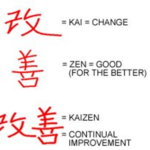
## Introduction to standard deviation in manufacturing
Standard deviation is a statistical measure that quantifies the amount of variation or dispersion in a dataset. In the context of manufacturing, standard deviation plays a crucial role in assessing and improving efficiency. By analyzing standard deviation in manufacturing processes, companies can identify areas of inconsistency and implement strategies to reduce variation, ultimately leading to improved productivity and cost savings.
Understanding the importance of standard deviation in manufacturing efficiency
Manufacturing efficiency is vital for any company looking to thrive in today’s competitive market. By minimizing variation and ensuring consistency in production processes, businesses can achieve higher product quality, reduce waste, and meet customer demands more effectively. Standard deviation serves as a key metric in measuring and monitoring the level of consistency in manufacturing operations.
A high standard deviation indicates that there is a significant amount of variation in the data, which can lead to inconsistent output and increased waste. On the other hand, a low standard deviation indicates that the manufacturing process is more predictable and consistent, resulting in higher efficiency and lower costs. Understanding and analyzing standard deviation is essential for identifying areas of improvement and implementing effective strategies for enhancing manufacturing efficiency.
Calculating standard deviation in manufacturing processes
To calculate standard deviation in manufacturing processes, data points related to the specific process need to be collected. This data can include measurements, weights, times, or any other relevant variables that impact the manufacturing output. Once the data is collected, the following steps can be taken to calculate standard deviation:
- Find the mean (average) of the data points by summing all the values and dividing by the total number of data points.
- Subtract the mean from each data point and square the result.
- Sum all the squared differences obtained in the previous step.
- Divide the sum of squared differences by the total number of data points.
- Take the square root of the result obtained in step 4.
The final value obtained is the standard deviation of the manufacturing process. This value represents the amount of variation present in the data and provides insights into the consistency of the manufacturing process.
Interpreting standard deviation in manufacturing data
Interpreting standard deviation in manufacturing data requires an understanding of the context and the specific process being analyzed. In general, a lower standard deviation indicates that the manufacturing process is more consistent, with less variation in the output. This can be attributed to factors such as standardized procedures, well-maintained equipment, and skilled operators.
Conversely, a higher standard deviation suggests that there is more variation in the output, indicating potential issues in the manufacturing process. This could be due to factors such as machine malfunctions, inconsistent raw materials, or inadequate training of operators. By interpreting standard deviation in manufacturing data, companies can identify the root causes of variation and take appropriate actions to improve efficiency.
Common challenges in reducing standard deviation in manufacturing
Reducing standard deviation in manufacturing processes can be a complex task, as it involves addressing various challenges that contribute to variation. Some common challenges faced by companies in reducing standard deviation include:
- Lack of data: In many cases, companies may not have access to sufficient data or may not collect data consistently. This makes it difficult to accurately assess the level of variation and identify areas for improvement.
- Complex processes: Manufacturing processes can be intricate and involve numerous variables. Understanding the relationships between these variables and their impact on standard deviation can be challenging, requiring advanced statistical analysis techniques.
- Resistance to change: Implementing changes to reduce standard deviation may face resistance from employees or stakeholders who are accustomed to existing processes. Overcoming resistance to change and ensuring buy-in from all parties involved is crucial for successful improvement initiatives.
- Limited resources: Allocating resources, such as time, personnel, and technology, to address standard deviation issues can be a significant challenge for companies, particularly those with limited budgets or competing priorities.
By recognizing these common challenges, companies can develop strategies and allocate resources effectively to tackle standard deviation and improve manufacturing efficiency.
Strategies for improving manufacturing efficiency using standard deviation
Improving manufacturing efficiency using standard deviation requires a systematic approach and the implementation of appropriate strategies. Here are some effective strategies that companies can adopt:
- Data collection and analysis: Ensure consistent and accurate data collection to understand the current level of variation and identify areas that require improvement. Analyze the collected data to gain insights into the root causes of variation and develop targeted improvement plans.
- Process standardization: Establish standardized operating procedures and best practices to reduce variation in manufacturing processes. This can include creating detailed work instructions, implementing quality control measures, and providing comprehensive training to operators.
- Continuous monitoring and feedback: Implement real-time monitoring systems to track key process variables and provide immediate feedback when variations occur. This enables quick corrective actions and prevents the recurrence of issues, leading to improved efficiency.
- Root cause analysis: Conduct thorough root cause analysis to identify the underlying factors contributing to high standard deviation. By addressing the root causes, companies can make sustainable improvements and reduce variation in manufacturing processes.
- Cross-functional collaboration: Foster collaboration between different departments and stakeholders involved in the manufacturing process. This promotes a holistic approach to reducing standard deviation, as it allows for the exchange of ideas, sharing of expertise, and alignment of goals towards improving efficiency.
By implementing these strategies, companies can effectively leverage standard deviation to drive continuous improvement in manufacturing efficiency.
Case studies: Successful implementation of standard deviation analysis in manufacturing
Several real-world case studies demonstrate the successful implementation of standard deviation analysis in manufacturing. One such example is Company X, a leading automotive manufacturer. Company X noticed significant variation in the thickness of paint coatings applied to their vehicles, resulting in inconsistent quality and increased rework. By analyzing standard deviation in paint coating measurements, they identified that equipment calibration issues were the primary cause of variation. By implementing a regular calibration schedule and training operators on proper equipment usage, Company X successfully reduced standard deviation and improved the consistency of paint coatings, resulting in higher customer satisfaction and cost savings.
Another case study involves Company Y, a pharmaceutical manufacturer. Company Y faced challenges in maintaining consistent tablet weight during the production process, leading to quality issues and wastage. Through standard deviation analysis, they discovered that variations in raw material quality were contributing to the problem. Company Y established stringent quality control measures for incoming raw materials, including supplier audits and material testing. By reducing the variation in raw material quality, Company Y significantly reduced standard deviation and improved tablet weight consistency, resulting in improved product quality and reduced waste.
These case studies highlight the effectiveness of standard deviation analysis in identifying and addressing variation in manufacturing processes. By adopting similar approaches, companies can achieve significant improvements in manufacturing efficiency.
Tools and software for tracking and analyzing standard deviation in manufacturing
To effectively track and analyze standard deviation in manufacturing, companies can leverage various tools and software solutions. These tools provide advanced analytical capabilities and streamline the data collection and analysis process. Here are some commonly used tools and software for tracking and analyzing standard deviation:
- Statistical Process Control (SPC) software: SPC software enables real-time monitoring and control of manufacturing processes, allowing companies to track key variables and calculate standard deviation. It provides visual representations of data, such as control charts, to identify trends and patterns that indicate variations.
- Data collection systems: Implementing automated data collection systems, such as Manufacturing Execution Systems (MES) or Enterprise Resource Planning (ERP) software, enables companies to collect accurate and consistent data. These systems can integrate with other manufacturing systems to capture data directly from machines and equipment, minimizing manual data entry errors.
- Data analysis software: Advanced statistical analysis software, such as Minitab or JMP, provides powerful tools for conducting in-depth analysis of manufacturing data. These software solutions enable companies to calculate standard deviation, perform regression analysis, and generate reports to visualize and interpret the results.
- IoT-enabled devices: Internet of Things (IoT) devices, such as sensors and actuators, can be used to collect real-time data from manufacturing processes. This data can then be analyzed using software tools to calculate standard deviation and identify areas for improvement.
By utilizing these tools and software solutions, companies can streamline the tracking and analysis of standard deviation, leading to more effective decision-making and improved manufacturing efficiency.
Training and resources for understanding and utilizing standard deviation in manufacturing
Understanding and utilizing standard deviation in manufacturing requires knowledge and expertise in statistical analysis. Companies can provide training and resources to employees to enhance their understanding and application of standard deviation. Here are some training and resource options:
- Statistical analysis training: Offer training programs or workshops on statistical analysis techniques, focusing specifically on standard deviation and its relevance in manufacturing. These programs can be conducted internally or outsourced to specialized training providers.
- Online courses and webinars: Online platforms provide a wide range of courses and webinars on statistical analysis and its application in manufacturing. Employees can access these resources at their own pace and acquire the necessary knowledge and skills.
- Internal knowledge sharing: Establish communities of practice or knowledge sharing platforms within the organization to facilitate the exchange of best practices and experiences related to standard deviation analysis. This promotes continuous learning and encourages employees to apply their knowledge in manufacturing improvement initiatives.
- Industry associations and conferences: Participate in industry associations and conferences that focus on manufacturing efficiency and statistical analysis. These events provide opportunities to learn from industry experts, network with peers, and stay up-to-date with the latest trends and practices.
By providing training and resources, companies can empower their employees with the necessary skills and knowledge to effectively utilize standard deviation in manufacturing processes.
Conclusion: Harnessing the power of standard deviation for continuous improvement in manufacturing efficiency
Standard deviation is a key metric for improving manufacturing efficiency. By understanding, calculating, and interpreting standard deviation in manufacturing data, companies can identify areas of improvement, reduce variation, and enhance productivity. Despite the challenges involved, implementing strategies such as data analysis, process standardization, continuous monitoring, root cause analysis, and cross-functional collaboration can effectively address standard deviation and drive continuous improvement. Real-world case studies demonstrate the successful implementation of standard deviation analysis in various industries, highlighting its potential for significant improvements in manufacturing efficiency. By utilizing tools and software solutions for tracking and analyzing standard deviation, companies can streamline the process and make more informed decisions. Furthermore, providing training and resources to employees enhances their understanding and utilization of standard deviation, ensuring continuous improvement in manufacturing efficiency. By harnessing the power of standard deviation, companies can achieve higher product quality, reduced waste, and increased customer satisfaction, ultimately leading to a competitive advantage in the manufacturing industry.
CTA: Improve your manufacturing efficiency today by harnessing the power of standard deviation. Contact us to learn more about how our tools and expertise can help you analyze and reduce variation in your manufacturing processes.
www.mmsrd.co.uk







